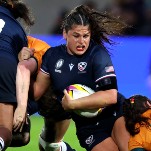How White Are the Women's Magazine Covers of 2016 So Far?
LatestWomen’s magazines, like the print business overall, have a notoriously poor history of foregrounding people of color, whether inside their pages, as subjects of their features, or of course, on their covers. Progress creeps along at the most marginal pace. Are the issues through the first half of 2016 any indication of what to look forward to for the rest of the year?
In a 2015 cover analysis, Fashionista revealed a dearth of color across the front of all women’s glossies; Fusion’s analytics, similarly, found that fashion mag covers featured only 14 percent women of color in 2014.
While some titles carried the status quo into 2016—mags tend to use their white readership demographic as an excuse to remain stagnant, from what I’ve noticed—others seem more committed to diversifying and shifting course. It could be that covers, generally, are now starting to reflect a moderately increased level of diversity in pop culture. Or it could be that a handful of magazines and cover stars are just doing the work.
Instead of waiting until the end of the year to tabulate cover stats, let’s examine the numbers in a midterm breakdown of 2016’s women’s mag covers thus far.
Vogue
In its January issue, Vogue overlord Anna Wintour announced efforts to join the real world and make the magazine’s coverage more inclusive, writing in her editorial: “All of the many progressive societal changes that we have experienced recently are pointing us to a place of far greater inclusiveness, tolerance and diversity.”
Seems like it would’ve been a perfect opportunity to put a person of color on the cover along with this diversity initiative. Instead, the issue features a considerably tanned Alicia Vikander. Vogue has since featured Penelope Cruz (she’s from Spain and thus considered white) on its February cover (she had to share it with Zoolander, a fake model from a terrible movie) and Rihanna on the April issue.
That is already a slight uptick—Vogue’s non-white covers went up from three in 2014 to four in 2015—and there’s time left in 2016. But one-and-a-half out of six covers so far in a year that started with a diversity letter is a pretty poor effort. Unlike some of its international counterparts—a la Vogue Espana, which had a black woman with cornrows on its March cover—Vogue still has no idea how to be a progressive face of fashion.
Grade: C-
Teen Vogue
Vogue’s cooler young sibling is doing an incredible job of diversifying, with four young women of color in its first six covers of the year, including Asian supermodel Fernanda Ly, Amandla Stenberg and Willow Smith. This means the magazine is mostly not white so far, a feat that is incredibly rare in the publishing biz, and representative of what seems to be an internal editorial trend. Teen Vogue went from one person of color on the cover in 2014 to four last year (three in 2013).
This could, of course, be attributed to the assorted and realistic tastes of its millennial fan base, on top of leadership. In May, Teen Vogue appointed its first-ever black Editor-in-Chief, Elaine Welteroth, who formerly served as their health and beauty director and had a hand in writing/editing the Willow and Amandla cover stories. Welteroth is also only the second black EIC in Conde Nast history (and the youngest).
-

-

-

-

-

-

-

-

-

-

-

-

-

-

-

-

-

-

-

-

-

-

-

-

-

-

-

-

-

-

-

-

-

-

-

-

-

-

-

-








































